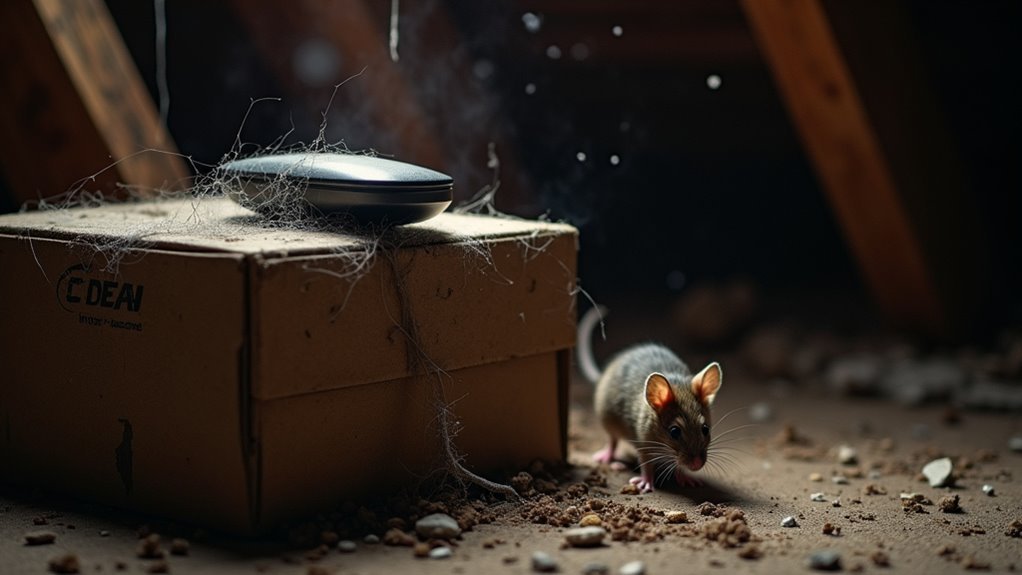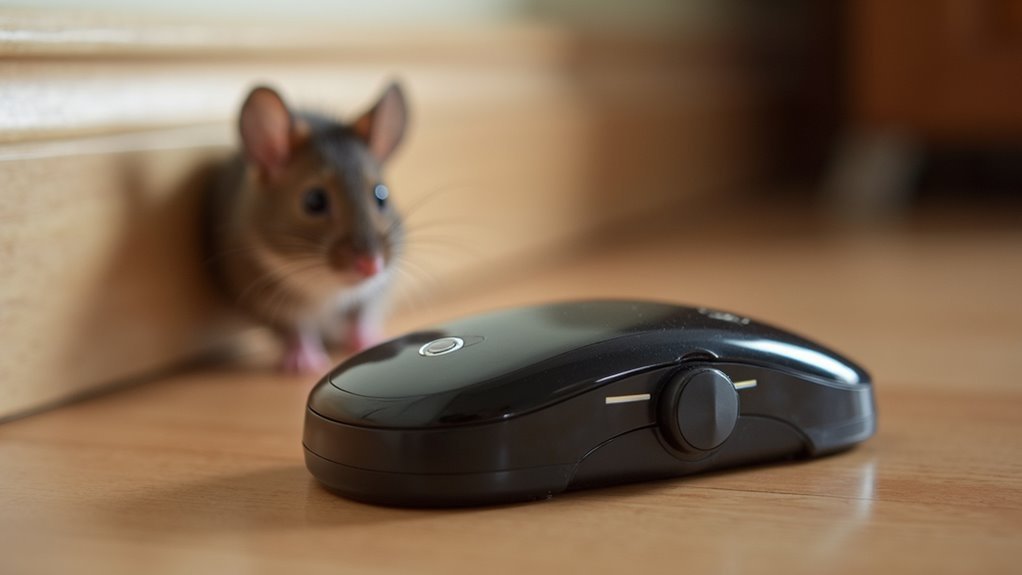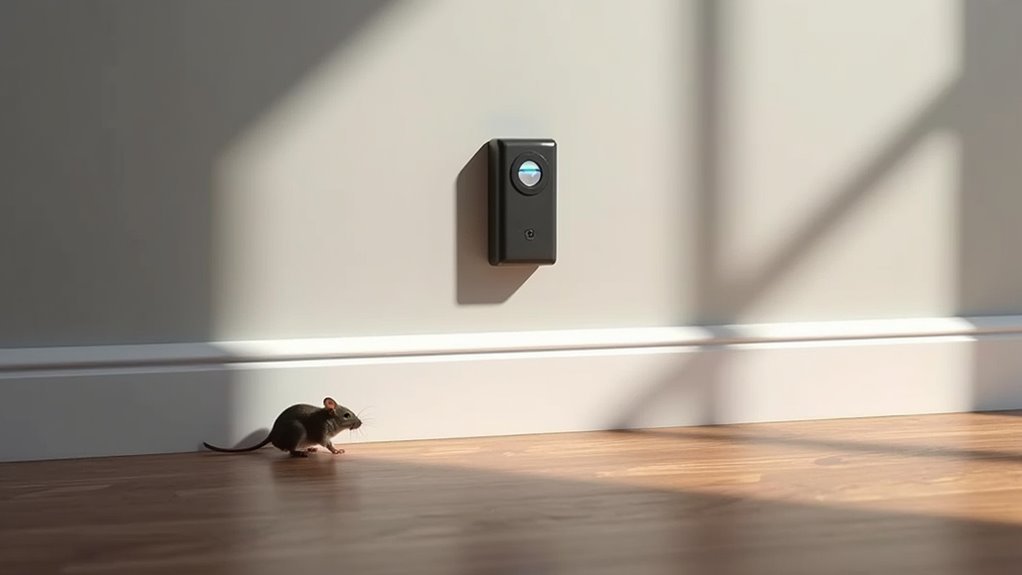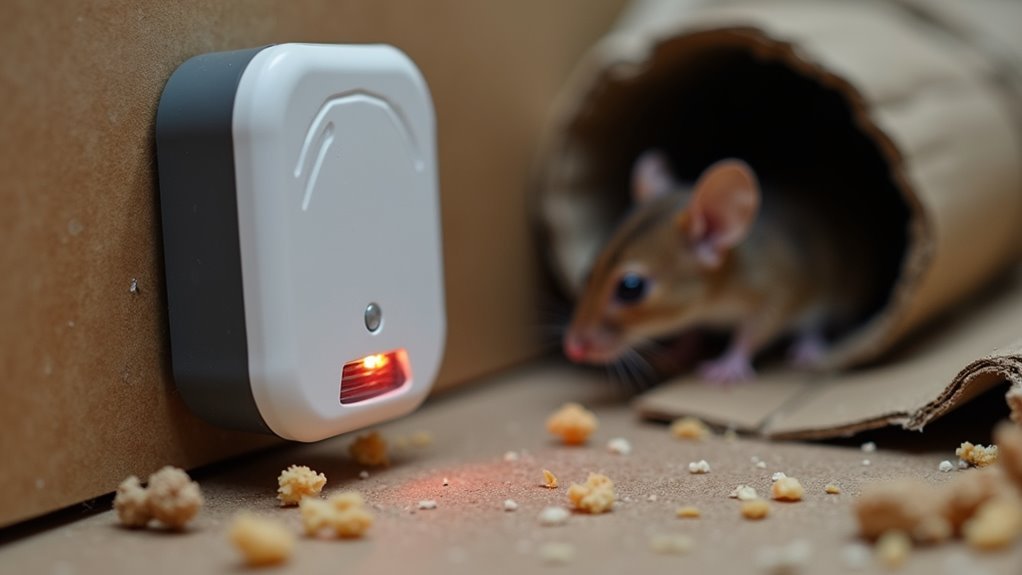Ultrasonic mouse repellers fail because mice quickly adapt to high-frequency sounds within 3-7 days, making the devices ineffective long-term. These sound waves can’t penetrate walls or furniture, creating safe zones where rodents remain unprotected. The limited 20-30 foot range leaves coverage gaps in larger spaces, while background noise from appliances disrupts transmission. Environmental factors like humidity and dust further reduce performance, and there’s minimal scientific evidence supporting manufacturers’ effectiveness claims. Understanding these limitations reveals why alternative pest control methods prove more reliable.
What Are Ultrasonic Mouse Repellers and How Do They Work?

When you’re dealing with a mouse problem, ultrasonic mouse repellers offer what seems like an appealing solution. These electronic devices emit high-frequency sound waves ranging from 20 kHz to 100 kHz that are inaudible to humans but supposedly bothersome to rodents.
Manufacturers claim these sound waves create an uncomfortable environment that can disrupt communication and navigation patterns in mice, making your home less hospitable to these unwanted guests.
You’ll find these devices marketed as a chemical-free approach to pest management, promising to drive away rodents without traps or poison.
However, scientific studies reveal concerning gaps in their effectiveness. While the concept sounds logical, research consistently shows little evidence supporting manufacturers’ bold claims about successfully repelling mice through ultrasonic technology alone.
The Science Behind Ultrasonic Sound Waves and Mice
You need to understand how ultrasonic frequencies between 20 kHz and 100 kHz interact with mouse hearing capabilities to grasp why these devices work initially.
Mice can detect sounds up to 90 kHz, which puts them squarely within the range of these repellers, but their auditory systems don’t remain static when exposed to consistent ultrasonic bombardment.
Your results will likely diminish over time because mice quickly develop habituation to these sounds, often adapting within just a few days of exposure.
How Sound Frequencies Work
The invisible battlefield between ultrasonic mouse repellers and rodents operates in a frequency range that exists beyond human perception. When you activate these devices, they emit high-frequency sound waves between 20 kHz and 65 kHz, targeting mice’s superior hearing capabilities that extend to 90 kHz. The goal is disrupting their communication and navigation systems, theoretically forcing them to abandon your space.
However, this frequency range faces significant obstacles. The ultrasonic sound waves can’t effectively penetrate walls and furniture, creating shadow zones where mice remain unaffected.
Environmental factors like background noise interfere with sound propagation, while room layout impacts coverage. Most critically, mice adapt to continuous ultrasonic sounds within days, becoming desensitized to what initially seemed like an effective deterrent against these persistent pests.
Mouse Hearing Range Limits
Mouse hearing capabilities extend far beyond human auditory limits, reaching frequencies up to 90 kHz compared to our maximum range of roughly 20 kHz. This superior hearing range means mice can detect ultrasonic sound that’s completely inaudible to you.
| Frequency Range | Detection Capability |
|---|---|
| 20-65 kHz | Standard repeller output |
| Up to 90 kHz | Maximum mice hearing range |
| Above 20 kHz | Beyond human detection |
| Variable levels | Background noise interference |
However, this doesn’t guarantee repellers’ effectiveness against these pests. While mice initially respond to ultrasonic frequencies, they quickly adapt within days, reducing long-term impact. Environmental factors like walls and furniture create sound shadows, limiting coverage. Background noise further compromises the repellers’ ability to maintain consistent ultrasonic output, ultimately diminishing their pest control effectiveness.
Adaptation and Habituation Effects
While ultrasonic repellers might initially startle mice, these adaptable creatures quickly develop tolerance to the persistent sound waves within just a few days.
Your ultrasonic repellers become ineffective as mice undergo habituation, a natural process where they adjust their behavior to ignore familiar stimuli.
Research demonstrates that rodents can thrive in environments with these devices, finding refuge in shadow zones where sound waves can’t penetrate obstacles.
The frequencies between 20 kHz and 65 kHz that these repellers emit lose their deterrent effect through adaptation.
The FTC has highlighted this lack of long-term effectiveness against mouse populations.
You’ll find that pests simply learn to coexist with the ultrasonic frequencies, making these devices unreliable for sustained rodent control despite manufacturers’ claims.
Limited Scientific Evidence Supporting Effectiveness Claims
Despite manufacturers’ bold marketing claims, ultrasonic mouse repellers lack robust scientific backing for their effectiveness. The Federal Trade Commission has specifically warned consumers about insufficient scientific evidence supporting these devices’ claims.
Multiple studies consistently demonstrate limited to no impact of sound waves on rodents and other common pests.
Research consistently reveals that ultrasonic sound waves produce minimal to zero measurable effects on mice and other household pests.
You’ll find that research reveals significant limitations in how ultrasonic pest repellers actually function. These devices emit sound waves with a limited range that can’t penetrate walls or furniture, creating “shadow zones” where mice remain completely unaffected.
Even more problematic, studies show that rodents become desensitized to ultrasonic frequencies within just three to seven days of exposure, rendering the devices fundamentally useless for long-term pest control solutions.
Mice Quickly Adapt and Become Desensitized to Ultrasonic Frequencies

Even if ultrasonic repellers initially startle mice, these adaptable rodents develop tolerance to the sound frequencies within three to seven days of continuous exposure.
You’ll find that mice quickly adapt to ultrasonic frequencies, making them desensitized to what was once an effective deterrent. This rapid habituation greatly undermines the effectiveness of your pest control efforts.
The continual bombardment of sound waves actually trains rodents to ignore the repellers completely.
Within just a few days, mice learn these ultrasonic frequencies pose no real threat, causing them to resume normal activities despite the device’s operation.
Studies consistently demonstrate this adaptation process, showing dramatic decreases in deterrent effects over time.
Your investment in ultrasonic pest control becomes worthless once mice recognize the sounds as harmless background noise.
Physical Barriers Block Ultrasonic Waves Creating Safe Zones
Beyond mice’s natural adaptation to ultrasonic frequencies, the physical properties of these sound waves create another fundamental problem for pest control.
Ultrasonic waves can’t penetrate walls or solid obstacles, creating shadow zones where rodents freely operate. Your furniture, appliances, and structural elements block these waves, establishing safe zones for pest activity.
Three critical limitations affect ultrasonic repeller performance:
- Limited effective range of 20-30 feet leaves larger spaces vulnerable
- Physical barriers like furniture and walls create sound-blocking obstacles
- Background noise from HVAC systems and appliances interferes with wave transmission
These shadow zones allow mice to find refuge behind couches, inside cabinets, or within wall voids.
You’ll discover that rodents quickly learn to exploit these protected areas, making your ultrasonic investment largely ineffective against determined pest activity.
Range Limitations Prevent Whole-Home Protection

While manufacturers market ultrasonic repellers as thorough home protection, their 20-30 foot effective range creates significant coverage gaps that leave most properties vulnerable.
You’ll find these range limitations particularly problematic in larger homes where ultrasonic mouse repellers can’t reach distant rooms or basements. Sound waves lose intensity as they travel, and background noise from HVAC systems or appliances interferes with frequencies.
Your coverage becomes even more spotty when furniture disperses the waves. Beyond the immediate effective range, shadow zones form where mice remain completely unaffected.
Even within range, pests adapt to the sounds within days, compromising long-term efficacy. You’d need multiple units strategically placed throughout your home, making whole-home protection expensive and impractical.
Environmental Factors That Reduce Device Performance
Your ultrasonic repeller’s performance isn’t just limited by range—environmental factors can greatly undermine its effectiveness.
Physical obstacles like furniture and walls create sound shadows where mice can hide, while dust and moisture buildup on the device dampens the ultrasonic waves it produces.
You’ll also find that high humidity and temperature fluctuations absorb sound frequencies, reducing both the intensity and reach of your repeller’s output.
Sound Wave Obstacles
Although ultrasonic mouse repellers promise convenient pest control, their sound waves face numerous physical barriers that can dramatically reduce their effectiveness.
When these devices emit ultrasonic frequencies, walls, furniture, and other obstacles become obstructed pathways, creating shadow zones where mice can remain undisturbed.
Your repeller’s performance suffers considerably when environmental factors like humidity and dust absorb or diffuse the sound waves.
Strategic placement becomes essential for ideal results:
- Position devices away from large furniture that blocks sound transmission
- Install multiple units in larger rooms to eliminate coverage gaps
- Avoid areas with high moisture levels that interfere with wave propagation
You’ll need to understand that these physical limitations mean ultrasonic repellers can’t provide the all-encompassing coverage manufacturers often claim.
Humidity and Temperature Effects
Beyond the physical barriers that block ultrasonic waves, environmental conditions create their own set of performance challenges for these devices.
High humidity levels greatly absorb sound waves, reducing the effectiveness of ultrasonic repellers by limiting how far high-frequency sounds can travel. You’ll find that dust and moisture interfere with the transmission of ultrasonic waves, creating shadow zones where mice remain unaffected.
Temperature fluctuations damage internal components of ultrasonic devices, causing reduced sound output or complete malfunctions. Environmental elements like rain and dust particularly weaken outdoor units’ emissions.
These conditions work together to compromise your device’s performance, especially in larger spaces where ultrasonic waves already struggle against absorption.
Why Marketing Claims Don’t Match Real-World Results
When you browse ultrasonic mouse repeller advertisements, you’ll encounter bold promises of pest-free homes and chemical-free solutions that seem too good to be true—and they typically are.
Marketing teams craft compelling narratives about pest repellers that scientific evidence simply doesn’t support. The Federal Trade Commission (FTC) has specifically warned manufacturers about making these unsupported claims.
Here’s why ultrasonic pest repellers fall short of marketing promises:
- Limited Range – Sound waves can’t penetrate walls or obstacles, creating shadow zones where rodents remain unaffected.
- Rapid Adaptation – Pests acclimate to ultrasonic frequencies within 3-7 days, rendering devices ineffective long-term.
- Species Variation – Most common pests don’t respond as advertised due to their natural ability to adapt.
Scientific studies consistently demonstrate these devices have little impact on rodent behavior or populations, making marketing claims misleading.
More Effective Alternatives to Ultrasonic Mouse Repellers
Since ultrasonic repellers don’t deliver on their promises, you’ll need proven methods that actually work against mouse infestations.
Start by sealing entry points around your home—gaps in walls and foundation cracks give mice and rats easy access. These pest control methods provide immediate prevention.
Snap traps offer a humane alternative that delivers quick results when properly placed and monitored.
Live traps work well if you prefer relocation, but you’ll need frequent checking to prevent suffering.
Maintaining a clean environment removes food sources and eliminates nesting opportunities. This control strategy deters mice from settling in your space.
For severe problems, professional pest control services provide tailored solutions using expert techniques that surpass what ultrasonic devices claim to offer.
Frequently Asked Questions
Do Ultrasonic Pest Repellers Really Work on Mice?
You’ll find ultrasonic pest repellers don’t effectively work on mice. They’ve limited range, can’t penetrate walls, and mice quickly adapt to the sounds, making them unreliable for serious rodent control.
How Long Do Ultrasonic Mouse Repellents Last?
You’ll typically get 3 to 5 years from your ultrasonic mouse repellent, but you should replace it sooner if you notice increased mouse activity or declining effectiveness from component degradation.
Do Ultrasonic Tick Repellers Actually Work?
You shouldn’t rely on ultrasonic tick repellers because they don’t work effectively. Ticks locate hosts using smell and heat, not sound, so these devices won’t protect you from tick bites reliably.
How Reliable Are Ultrasonic Pest Repellers?
You can’t rely on ultrasonic pest repellers for effective pest control. Scientific studies show they’re largely ineffective, pests adapt quickly, and the FTC’s warned about misleading marketing claims regarding their performance.
In Summary
You’ll save money and frustration by skipping ultrasonic mouse repellers. They don’t deliver the results manufacturers promise, and mice quickly adapt to the sounds anyway. You’re better off investing in proven methods like snap traps, bait stations, or sealing entry points. Don’t let clever marketing fool you – ultrasonic devices won’t solve your mouse problem. Choose traditional pest control methods that actually work instead.





Leave a Reply